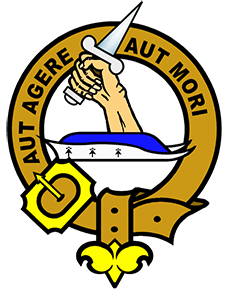Barclay Clan
Barclay Crest: Out of a chapeau azure ermine a hand holding a dagger proper.
Barclay Clan Motto: Aut Agere Aut Mori (Either action or death).
Barclay Clan History: The Barclay surname is of Norman origin. Family tradition suggests that Roger, Provost of Berkeley, Gloucestershire, had a son, John de Berchelai, who in 1076 travelled to Scotland with the train of
Queen Margaret. Margaret married Máel Coluim mac Donnchada (Malcolm III "Canmore"). Malcolm Canmore granted John lands at Towie in the parish of Turriff, Aberdeenshire. The Barclay's, through marriages and alliances
soon established themselves as an influential family throughout Aberdeenshire and Banffshire.
John's de Berchelai's son, Walter is said to have been the 3rd Laird of Gartly in Strathbogie, and his Grandson, Sir Walter, was Chamberlain of Scotland 1165-1189. As little is written of the Towie branch until
the 1500's it appears that Gartly line, for several hundred years, were main branch of the Barclay family in North East Scotland.
Sir Walter de Berkeley, the 8th Laird of Gartley signed the Ragman Roll and did homage at Berwick 1296. In 1305 he was appointed Sheriff of Banff by King Edward I.
Andrew de Berkley, the 9th Laird of Gartley supported Robert the Bruce, and was executed by the English after raiding into Yorkshire in 1322.
Sir John de Berkeley the 10th Laird of Gartley witnessed the grant by Sir William Keith, Marischal of Scotland in 1351, of the lands of Mathers in St Cyrus, Kincardineshire, to his brother Alexander.
George Berclay the 5th Laird of Mathers along with his uncles Patrick and John and several local lairds murdered and boiled John Melville of Glenbervie, Sheriff of the Mearns in 1421. Melville was overly zealous in attention
to his duties and his arrogance made him extremely unpopular among the local lairds.
The Lairds complained vociferously over the years to Murdoch the Duke of Albany. The Duke became weary of the constant complaints and is quoted as stating to Berclay 'sorrow gin that sheriff were sodden and supped
in broo'.
Taking the Dukes statement literally, Berclay together with his uncles, and the local Lairds invited Melville to a great hunt in the forest of Gavock, where a large fire and cauldron of boiling water had been earlier prepared. After luring the unsuspecting Melville to the area he was beaten down, stripped and thrown into the cauldron. After boiling the Sheriff for some considerable time the protagonists each had a spoonful of the soup. Berclay was some years later pardoned for his role in the affair.
Sir Alexander Barclay the 13th Laird of Gartley was slain at the battle of Arbroath in 1446.
In 1516 King James V. granted Walter Berclay of Towie a charter uniting all Barclay lands into one Barony of Barclay. Towie Barclay castle was constructed in the mid-16th and was held by the Barclay family until it was sold in 1755.
Thomas the Rhymer's poem, "Towie Barclay of the glen happy to the maids, but never to the men", was said to be a curse on the males of the Barclay family. The "curse" was given a great deal of credence locally and was said to have been the reason for the sale of the castle.
Colonel David Barclay the first Laird of Urie served with distinction under Gustavus Adolphus the King of Sweden. He returned home to fight in the civil war. In 1647 he purchased the lands and barony of Urie from William, 7th Earl Marischal. His grandson, David, went on to found Barclays bank in London.
Places of Interest: Allardice Castle, nr. Inverbervie, Aberdeenshire. 17th century castle which passed to the Barclays of Urie in 1776. Ardrossan Castle, Ardrossan, Ayrshire. 15th century castle built on the site of an earlier Barclay castle. Balmakewan, nr. Marykirk, Aberdeenshire. Little remains of this castle which was home to the Barclays in the 17th and 18th centuries. A 19th cenury mansion house and farm now sits on the estate. Balvaird Castle, nr. Bridge of Earn, Perthshire. 15th century castle, built by the Barclay family, who held it until 1500. Collairnie Castle, nr. Cupar, Fife. Tower house owned by the Barclays from the 1300's until 1789. Kaim of Mathers Castle, nr. St. Cyrus, Aberdeenshire. Built by the Barclays of Mathers in the early 1400's, the remains of this castle, much having already been claimed by the sea, are perched precariously on cliffs, overlooking the North Sea. Kilbirnie Place, nr. Kilbirnie, Ayrshire. Ruins of a tower house which was built on lands held by the Barclays in the 1400's. Monboddo House, Auchenblae, Aberdeenshire. Property held by the Barclays from the 1200's until the late 1500's. Red Castle, nr. Inverkeilor, Angus. This ruined tower house, overlooking Lunan Bay, was constructed by the Barclay family in the 12th century. Towie Barclay Castle, nr. Turriff, Aberdeenshire. Constructed by the Barclays in 1593, on lands held by the family from the 1100's, this 16th century castle was the main seat of the Clan for over 600 years. Ury House, nr. Stonehaven, Aberdeenshire. Ruined mansion house, incorporating an earlier tower house, constructed in the 16th or 17th century. Owned by the Barclays of Mathers and Urie during the 1600's and 1700's
Surname distribution in Scotland: The Barclay name is most commonly found in Aberdeenshire, Aberdeen City, Moray (includes large parts of historic Banffshire), Angus (Forfarshire), Fife, Ayrshire and Highland which incorporates the historic counties of Caithness, Inverness-shire, Nairnshire, Ross and Cromarty, Sutherland and small areas of Argyllshire and Morayshire.
Buy a unique Clan Barclay membership certificate.

